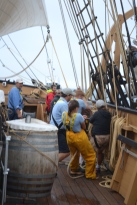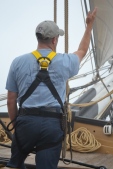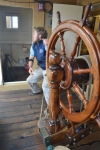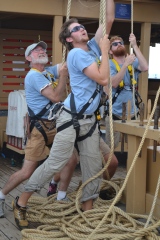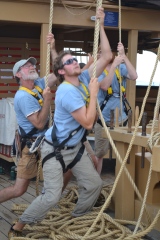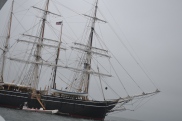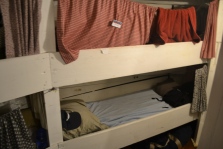I wanted to get to know the workers on board the Morgan because, as a biographer, I need to gain some sense of Melville’s work environment. But this “sense” I hope to achieve is a far cry from the reality Melville experienced, and my own 21st-century experiences on the Morgan can only be a faint simulation of what he experienced in 1841. So I must keep in mind that for one day only I am only imagining what another man’s life only might have been. That’s a lot of “only,” and perhaps all I can do in writing a biography is measure the distance between my present and Melville’s past. Still, one boundary these two spheres share is our common humanity; if only I might isolate, for one day, one or two of these shared humanities.
I had witnessed the work on board the Morgan: the running to stations, the pulling and heaving, the call and repeat, the unity of body and action. Now I wanted to know the workers, from the youngest on board to captain, as individuals: what they thought and felt. Maybe here would be the connection. I had little time for extensive interviewing, and no illusion that in less than a day I could really “get to know” anyone, much less a group of workers busy at work. Often my interviewees stopped their responses in mid-sentence with a polite “I gotta go” when first mate Sam or second mate Sean yelled out a command. So I developed a concise two-question approach that I hoped would allow me sufficient entrè into the varied lives of the crew: How did you get into this profession? What is your biggest fear?
Of course, the two questions were a mirror of myself: who am I and why do I fear death? But I also had Melville in mind and, in particular, his brilliant (lesser known) novel Redburn, an autobiographical fiction based on his adolescence that is therefore an important though problematic source for any biographer. In Ch. 16, Redburn is made to climb aloft to the highest yard in the dark of night to release the gaskets that tie up the highest smallest sky-sail. Standing on the skysail yard, Redburn reflects:
For a few moments I stood awe-stricken and mute. I could not see far out upon the ocean, owing to the darkness of the night; and from my lofty perch, the sea looked like a great, black gulf, hemmed in, all round, by beetling black cliffs. I seemed all alone; treading the midnight clouds; and every second, expected to find myself falling—falling—falling, as I have felt when the nightmare has been on me.
I have always related to this passage: the darkness, muteness, and falling. I have a healthy respect for heights. I like to hold tight to railings. When I’m on a balcony, I imagine myself pitching over and have to shake off this “imp of the perverse” death-wish (as Poe might call it). Three years ago, I witnessed a person throw herself off a five-story parking structure in San Diego: I saw her fall; I heard the slap-crack as her body hit the pavement like lumber, and I must shake off this image, night or day, whenever it invades my mind.
On board the Morgan, I had no time to explore the crew’s fears in such detail, and I knew that even in asking the question, I risked unconsciously coaxing them in their response toward my agenda of exploring Melville’s self-doubting expressions of fear rather letting them express their own authentic being. But, I reasoned, if the present crew is a sphere completely separate from the sphere of Melville’s past, one common link between then and now is this form of our shared humanity. Fear is trans-historical, and my job was to ask and listen to these sailors not listen to myself.
One respondent, the youngest of the professional crew with three years experience under sail on tall ships, was utterly unresponsive even to my first question: how did you get started working at sea? He gave only laconic, single word utterances, and I never got to my second question: it seemed fruitless to attempt it. I left him to his solitude, which I deeply respect.
Others were more open in relating their life histories: they had been on a boat of some sort since the age of four, ten, twelve, clocking from ten to twenty years working summers or full time on ships powered by engines or wind. I did not ask them if they loved the sea, if it had some pull on them, or metaphysical depth. Their eyes were on the deck and the rigging and not on the horizon. One had been at it long enough, he said, and he was set to quit in a year or so and return to college, get a degree, and make some money. For many, this sea life is a transition to something else. Melville, for instance, left the sea and became a writer, which as far as we can tell, is when he began to reflect back on the pull of the sea and its metaphysical depth.
My second question was hard to ask because fear is something people do not readily admit to. Men are often reticent with regard to this subject, so I fully recognize how the question What is your biggest fear? can be taken as an assault on a man’s manhood. The Fear Question is the opening of an issue that the culture tells men not to address. This mute stoicism is a venerable precept of courage, although, paradoxically perhaps, another precept is that writing about your fears is itself an act of courage, and one Melville manages quite well. A common enough initial response to the FQ was “spiders.” The humor is that a big guy cringes at a little crawling thing, and we chuckled at this opener, though, any sensible man will tell you spiders are scary.
A second, understandable evasion was to ask whether I meant fear in general or fear at sea. And I would let that ride: whichever, I would say; start where you want.
I was undeterred in asking this number two question, expecting that when I got people finally to relent they would respond mostly along the lines of Redburn’s fear of falling falling falling. He relates this to “the nightmare,” which is the common enough anxiety dream of falling that many have experienced. And why should a young man dream of falling? What anxieties could possibly afflicted a young man? For starters there is failing to succeed, to love and be loved, to be a man, to find a mate. Falling is a form of failing. The two seem closer than just one letter apart. But no one mentioned this.
 Although, one worker after some thought beyond the spider stage of response said, he mostly feared “freezing up” in the rigging. I thought he meant that his forearms, wrist, and hand might, from all the gripping and holding, cramp and go numb, but no, the fear is being up in the rigging and not knowing whether to climb up or down, slide right or left. Which line will secure you, which one is loose. Freezing up is when you cannot tell. The issue is not falling, but not knowing where to go.
Although, one worker after some thought beyond the spider stage of response said, he mostly feared “freezing up” in the rigging. I thought he meant that his forearms, wrist, and hand might, from all the gripping and holding, cramp and go numb, but no, the fear is being up in the rigging and not knowing whether to climb up or down, slide right or left. Which line will secure you, which one is loose. Freezing up is when you cannot tell. The issue is not falling, but not knowing where to go.
In Redburn, Melville writes that it is not enough for a young sailor “to learn the ropes.” In fact, that expression, which we take to indicate expertise, really is only the beginning of what a sailor in the rigging must learn, not just the names of the lines but their relation to each other, and one’s relation to the line. To pass from a boy to a sailor man, Redburn tells us, means becoming “an artist in the rigging.” This modern sailor knew this truth all too well. He was as much an artist in the rigging as any of his crew mates, but he also knew that no artist can get lost in his revisions, that even the best artist in the rigging can “freeze up.” Others listening knew what he meant.
Another long-time sailor spoke of fire in the hold. A ship is a bit of tinder floating in the sea; it’s all wood and hemp; it is designed to keep water out; fire travels fast below deck. And this person’s insight birthed another, a fear of being cast on a lifeboat at sea. I think he was on a roll and might have listed more fears of the sea, but a command went out, and he ran off, repeating the command.
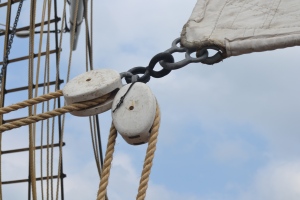 An unexpected fear came up in an unrelated conversation with one of the crew’s more experienced members: the snapping of the canvas sails as they billow out. We assume this sound, like the revving of an engine, signals the beginning of some romantic sea adventure, or at least wind in the sails and forward movement. But, she cautioned, the force of a flapping sail can break the line that holds it, which means the loose end of the sail with its ropes, block, and tackle can slap you in the face or push you off a spar. If you hear a snap, you better duck or hold on tight.
An unexpected fear came up in an unrelated conversation with one of the crew’s more experienced members: the snapping of the canvas sails as they billow out. We assume this sound, like the revving of an engine, signals the beginning of some romantic sea adventure, or at least wind in the sails and forward movement. But, she cautioned, the force of a flapping sail can break the line that holds it, which means the loose end of the sail with its ropes, block, and tackle can slap you in the face or push you off a spar. If you hear a snap, you better duck or hold on tight.
Eventually, I worked up nerve to ask my questions to the captain, Kip Files. It occurs to me now how presumptuous I was in asking the captain what he fears. Maybe it is not good deck etiquette to ask the person in charge of the very piece of wood that is keeping you afloat in the Atlantic anything that approaches self-doubt, or interior searching. Frankly, I want my captain courageous. Unconsciously, I seem to have been re-enacting an embarrassing moment in Redburn when the young man approaches his captain, as if they were gentlemen of equal rank, and he is summarily rebuked for thinking he might pay the captain a social call. What had I been thinking? But Captain Files honored my question with respect, though perhaps a quizzical look, as if to say do you really want me to tell you I fear sinking, drowning, falling? But his diplomatic response was a telling mix of confidence and anxiety: he feared failure, in particular, failing to get the Morgan into Boston on time. And while I thought at the time that this was a spider-like evasion, I see now a truth embedded in his authentic response: his fear of failing is a version of my fear of failing.
Our “38th Voyager” crew coordinator, Paul O’Pecko grabbed me. I was on the list to climb the rigging, and I was next. Weather permitting, we were allowed aloft but only up to just under the platform where the shrouds meet the foremast or mainmast. More experienced sailors climb over this platform or through the “lubber hole” in the platform. More experienced sailors continue up higher on rope ladders, or out on foot ropes sagging beneath spars, or slide down stays that keep masts secured. I was not an experienced sailor, but knew I had to do this.
Fellow voyager Jason had just descended and gave me the harness we are required to wear, as do all sailors. The straps fit tight around your shoulders and up your crotch. Does that feel comfortable? Dana coyly asked. Tolerably, I said. Then the harness is not tight enough, she said. So I cinched it up to uncomfortable, climbed onto the bulwarks with nothing but the sea moving past me below, and climbed the shrouds with nothing but deck below, following Dana’s instructions always to maintain three points of contact: two hands and one foot; two feet and one hand. Our harness came with a loose strap ending with a clasp, which we are to use at the top to clip on to a secure line as we look around.
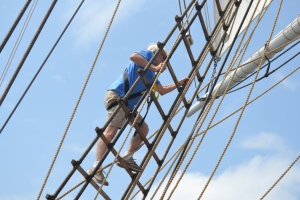 As I climb the ever-narrowing wooden rungs of the shroud, I wonder what use this clasp is while I am climbing. I could fall to the deck, like lumber, as I climbed, the strap and clasp flailing in the descent. Nor did I pause to look at the horizon; or up to the platform; or down to the deck; only at the whiteness of my knuckles as I muttered, “three points of contact; three points.”
As I climb the ever-narrowing wooden rungs of the shroud, I wonder what use this clasp is while I am climbing. I could fall to the deck, like lumber, as I climbed, the strap and clasp flailing in the descent. Nor did I pause to look at the horizon; or up to the platform; or down to the deck; only at the whiteness of my knuckles as I muttered, “three points of contact; three points.”
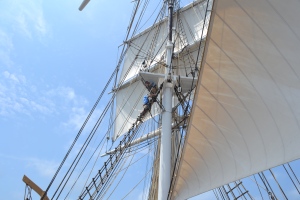 Sitting aloft was Chris, who kept me company as I clipped onto to a line he had a liking for. I had no questions for Chris about his career or his biggest fear. I could see the bow of the ship as it cut the water and the deck spreading beneath me, and I turned as well to wave to friends below, who looked mighty small. I am still a respecter of heights.
Sitting aloft was Chris, who kept me company as I clipped onto to a line he had a liking for. I had no questions for Chris about his career or his biggest fear. I could see the bow of the ship as it cut the water and the deck spreading beneath me, and I turned as well to wave to friends below, who looked mighty small. I am still a respecter of heights.
 I asked Chris how often the wooden rungs of the shrouds break, and as I descended, I could not help repeat to myself his answer: “Almost never.”
I asked Chris how often the wooden rungs of the shrouds break, and as I descended, I could not help repeat to myself his answer: “Almost never.”


